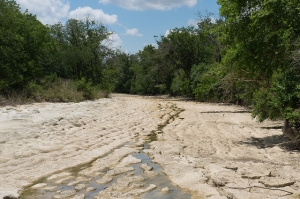
Parts of Texas are edging back toward drought conditions after a short three-month reprieve from five years of severe to extreme drought. In the Southwest, drought conditions have existed for 11 of the last 14 years.
Water resources are being depleted. The summer months, when water demand skyrockets, are almost upon us and resources will be strained even more. Population growth throughout the state continues to explode and additional water capacity is sorely needed.

Photo of Blanco River by Earl McGehee licensed under CC BY 2.0.
Some funding is now available and a few smaller water projects have been launched, but funding is inadequate for large public projects that would fix the problems in many regions. Private-sector capital is abundant, but municipal leaders in Texas have been reluctant to enter into collaborations with private-sector partners. In other states, public officials have turned to public-private partnerships (P3s) for remedies. They have been eager to transfer risk, take advantage of leading-edge expertise and welcome private capital investments. Not so much in Texas.
A report released this week by Bluefield Research indicates that more than $58 billion will be invested globally in water projects financed through public-private partnerships by 2020. The report also indicates that of the $58 billion in new projects, 80 percent of the money will be invested in new seawater desalination and wastewater treatment plants.
The United States has captured global attention because companies with experience in large collaborative water projects in many other countries are aware of the needs here. Some have moved people to the U.S. and a few are already involved in P3 water projects. One new facility in the U.S. is a $1 billion facility in San Diego. It is the largest seawater desalination plant in the Western Hemisphere and it was designed to produce up to 50 million gallons of fresh water every day.
Although Texas currently has no major plants that desalinate seawater, that could change soon. Last August, the state explored the possibility of building a seawater desalination plant in the San Patricio-Nueces County region with a private-sector partner, and the Guadalupe Blanco River Authority was recently awarded a $2 million loan from the Texas Water Development Board (TWDB) to defray the costs of a feasibility study for a proposed seawater desalination plant.
A few small projects are under way. Last April, the city of Early approved issuing $8.36 million in bond certificates following a loan from the TWDB to build a new wastewater treatment plant. Another project, the expansion of the Stewart Creek Wastewater Treatment Plant, is expected to cost about $20 million. But, for larger projects, delay after delay is the norm.
With water needs in Texas expected to increase by 70 percent by the year 2060, the state will undoubtedly be a major contributor to the anticipated global increase in water projects. One has to wonder when public officials with critical water needs will reach out to private-sector partners and start talks about collaboration. Those actions surely are inevitable because the amount of public funding required to fix the water shortages in Texas is simply not available.
SPI’s newsletters track contracting news in Texas and throughout the nation, subscribe today!
